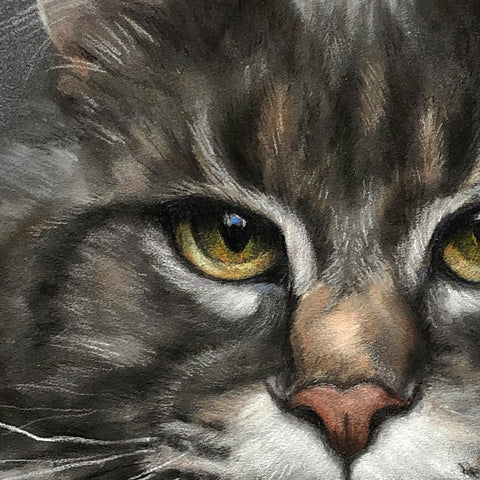Pet Portrait Pitt Pastel Tutorial - Maine Coon Cat

A pet portrait tutorial with Pitt Pastel Pencil tips and tricks.
“Art doesn’t have to do anything. It just has to be there for the fierce pleasure we take in doing it.” – Raymond Carver, Writer and Poet

Maine Coon Cat
How to Be a Fierce Artist: Part 1
Have passion.
Passion is a powerful state of mind for the artist. Most of the world’s greatest art is born of it. Without passion, you lose interest or settle for mediocre. Passion is the fuel that drives you to create with excitement, and to excel. It motivates you to persevere during times of struggle or frustration with your art. Passion can keep you up at night, or haunt you in your sleep. You wake up in the morning with a sense of excitement to return to your artwork. Art is on your mind much of the time. It is a love, a determination to excel, a fierceness. If you have already found your passion, then you know how to harness it and use its creative energy to exercise your imagination and expand your artistic skills. You realize that you have tapped into the potential you never knew you had.
If you are in search of your passion, begin by committing yourself by finding a permanent place and time to create. Get yourself some of the best art materials that you can afford. Passion often develops simply from exploring quality art materials and discovering the many exciting possibilities for artistic expression. Inspiration is all around; in nature, travel, memories, and so much more. Look at other interesting artists both modern day and throughout history—their lives, their work. There is a wealth of exciting, easily accessible tutorials (often free) that can be found for all mediums, online. The more time you devote to this interest, the more you learn, and the more satisfying results you achieve with your art. A fierce artist has passion.
Pitt Pastel Pencils offer the artist the best of both worlds, combining the confidence and control of a pencil with the soft, looser mark of pastel. The colors can be blended and layered just as they would in a soft pastel painting. Their pencil form also allows the pastel to be easily sharpened to a point and be used for developing details in artwork.
The Pitt Pastel Pencil lead contains a high level of pigment, making the pencils ideally suited both for drawing lines and shading, as well as blending and merging into delicate color transitions. Their light, clean application creates significantly less dust than other pastel chalks during use, allowing artists to enjoy pastel techniques without the mess that often accompanies them.
Pitt Pastel Pencils come in a comprehensive range of 60 vivid colors, and are lightfast and acid-free. They are also conveniently color-matched to all other Faber Castell Art & Graphic Products, enabling reliable mixing techniques of all artists’ materials.
These professional quality Pitt Pastel Pencils are offered both individually and in tins of 12, 24, 36 and 60 pieces. The full range of 60 pencils offer an assortment of beautiful colors featuring extensive shades for landscapes, portraits, design, etc..
Faber Castells’ traditional commitment to producing the highest quality art materials available insure the artist with the creative inspiration they seek for producing unique and professional works of art.
Experience the pleasure of what pure quality has to offer.
Techniques:
Shading
Pitt pastel pencils when held at an angle produce even, flat color for shading and coverage. A variety of color intensities can be achieved by the amount of pressure used with the pencil.
Parallel Hatching / Cross Hatching
Hatching is a technique of drawing fine parallel lines close together to give the effect of shading. The closer together the lines are, the darker the area appears.
Cross hatching are hatching marks overlapped at different angles. Depending on the density of the lines and number of colors used, new tones can be created.
Mixing and Smudging
Smudging is a technique where colors are rubbed into the paper with a finger, blending stump or cloth. Soft, smooth color gradients can be created by smudging the lighter colors into the darker colors.
Blending
Blending color is very easy with Pitt pastel pencils. It is possible to achieve outstanding effects using just the pencils themselves. It is also possible to blend with a finger to achieve a good solid color. Blending stumps and other paintbrush-like tools with various rubber tips offer excellent blending results for small areas that are impossible to achieve with a finger.
Fixing
Due to the absence of waxes and oils in Pitt pastel pencils, a fixative is recommended to prevent unwanted smudging and to protect the final piece of art. Using fixative also offers another great advantage. You can spray throughout your art process to restore tooth to continue with layers of pastel. Note that while a fixative successfully binds the pigments, it can also slightly darken the colors.
Glazing Color
Glazing is a very effective technique where a very thin layer of color is applied over another. This creates an optical mixture with the base color shining through the upper layer of color.
Mixed Media
Pitt Pastel Pencils are also popular for use in combination with Albrecht Durer Artists’ Watercolor Pencils. Interesting creative effects can be achieved with pastel pencil applied on top of dried watercolor.
Making Corrections
A vinyl eraser will completely remove pastel color while a kneaded eraser can gently lift and lighten color.
Tips for Using Pitt Pastel Pencils for Animals
1. Choose a sanded paper meant for pastel or a paper with enough tooth to hold the pigment and accept layers of pastel. Toned paper is also a popular choice, as it presents a neutral background to go both lighter and darker with your pencils.
2. Lighten your outline drawing with a kneaded eraser before you begin to draw and color over it.
3. Use the side of the pencil for shading in the foundation color of the animal.
4. Draw fur in the direction it is growing in.
5. Work dark to light.
6. Use fingers for blending sparingly, and experiment with using other pencils, paper stubs or color shapers for blending.
7. Avoid accidentally smudging your work by using a piece of tracing paper or glassine (protective sheets of glassine can be found in sanded paper pads) under your drawing hand.
How to:
Drawing a cat’s eye
I begin by transferring my light outline drawing of the cat to my grey sanded pastel paper, and start with the eyes.

Here I draw over the outline and pupil with my black pastel pencil. I also lightly color in a shadow under the top eyelid, and add the white highlight in the pupil.

Here I lightly color in a few yellows and greens to the eye.

Finally, I gently blend the colors in the eyes and add a spot of blue to the white highlight.

I then continue with the rest of the face.


